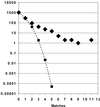Large-scale comparison of intron positions among animal, plant, and fungal genes
- PMID: 12444254
- PMCID: PMC138576
- DOI: 10.1073/pnas.242624899
Large-scale comparison of intron positions among animal, plant, and fungal genes
Abstract
We purge large databases of animal, plant, and fungal intron-containing genes to a 20% similarity level and then identify the most similar animal-plant, animal-fungal, and plant-fungal protein pairs. We identify the introns in each BLAST 2.0 alignment and score matched intron positions and slid (near-matched, within six nucleotides) intron positions automatically. Overall we find that 10% of the animal introns match plant positions, and a further 7% are "slides." Fifteen percent of fungal introns match animal positions, and 13% match plant positions. Furthermore, the number of alignments with high numbers of matches deviates greatly from the Poisson expectation. The 30 animal-plant alignments with the highest matches (for which 44% of animal introns match plant positions) when aligned with fungal genes are also highly enriched for triple matches: 39% of the fungal introns match both animal and plant positions. This is strong evidence for ancestral introns predating the animal-plant-fungal divergence, and in complete opposition to any expectations based on random insertion. In examining the slid introns, we show that at least half are caused by imperfections in the alignments, and are most likely to be actual matches at common positions. Thus, our final estimates are that approximately equal 14% of animal introns match plant positions, and that approximately equal 17-18% of fungal introns match animal or plant positions, all of these being likely to be ancestral in the eukaryotes.
Figures


References
Publication types
MeSH terms
LinkOut - more resources
Full Text Sources
Medical
Research Materials

